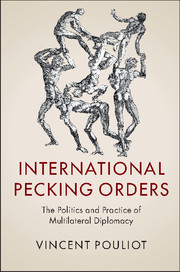Book contents
- Frontmatter
- Contents
- List of figures
- List of tables
- Preface and acknowledgments
- List of abbreviations
- Introduction: All the world's a stage
- Part I Situations
- Part II Dispositions
- Part III Relations
- 5 Permanent representation: relational structure and practical logics
- 6 Clan politics: Security Council reform and the UN pecking order
- Part IV Positions
- Conclusion: The “miracle” of multilateral pecking orders
- Appendix: Research design, methods and data
- References
- Index
5 - Permanent representation: relational structure and practical logics
from Part III - Relations
Published online by Cambridge University Press: 05 March 2016
- Frontmatter
- Contents
- List of figures
- List of tables
- Preface and acknowledgments
- List of abbreviations
- Introduction: All the world's a stage
- Part I Situations
- Part II Dispositions
- Part III Relations
- 5 Permanent representation: relational structure and practical logics
- 6 Clan politics: Security Council reform and the UN pecking order
- Part IV Positions
- Conclusion: The “miracle” of multilateral pecking orders
- Appendix: Research design, methods and data
- References
- Index
Summary
The NATO case study presented in Chapter 4 illustrated how pecking orders owe to situated struggles for competence (Part I) and embodied diplomatic feelings (Part II), as well as peculiar features of permanent representation to IOs. In critical ways, social stratification is imbricated with the ways in which multilateral diplomacy is organized at the level of relationships. Part III of the book seeks to characterize permanent representation to IOs as a social form. Taking the structure of social ties seriously, this chapter focuses on two key dimensions: morphology and attendant practical logics. What are the relational specificities of permanent representation and what social dynamics do they spark? As a social form, does multilateral diplomacy generate a distinctive set of pecking order dynamics? While each multilateral setting comes with its own peculiarities at the level of practice, in this chapter I seek to theorize some commonalities in the relational structure and practicality of permanent representation that can travel across multilateral sites.
Despite the abstract nature of the exercise, the modeling of multilateral diplomacy that follows is the result of deep induction and prolonged immersion in the social theaters of interest. During fieldwork, it appeared that the practice of permanent representation takes place within a particular kind of relational structure. Looking for a framework to organize empirical findings along analytically general categories, I settled on Nexon's “relational analytics” in order to ideal-typify the otherwise very messy and complex social context of multilateral diplomacy. As Chapter 6 will illustrate with the case of UN Security Council reform debates, this framework provides useful analytical tools to make sense of a key set of structural forces in the multilateral diplomatic process.
Drawing from social network theory, relational analytics conceives of structures as “ongoing, dynamic patterns of transaction between actors and other social sites.” The key insight is that the ways in which social ties are organized help understand political dynamics, including the relational sources of standing that players may cash out in and through practice. I look at four main relational dimensions of permanent representation: (1) the size and reciprocity of the configuration; (2) its connections to the outside; (3) the density of its ties; and (4) the distinctive position of the head. Taken together, I argue, these four dimensions capture the peculiar morphology of permanent representation to IOs.
- Type
- Chapter
- Information
- International Pecking OrdersThe Politics and Practice of Multilateral Diplomacy, pp. 119 - 153Publisher: Cambridge University PressPrint publication year: 2016



